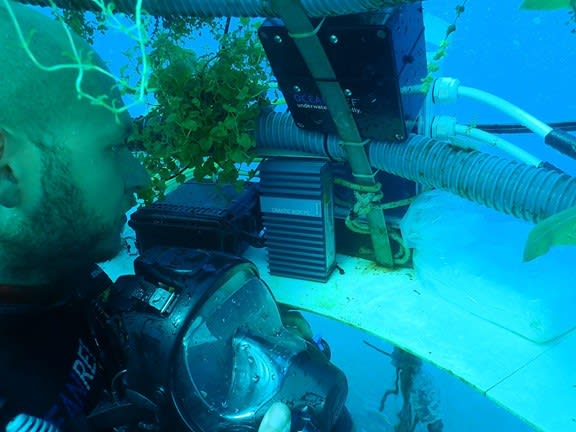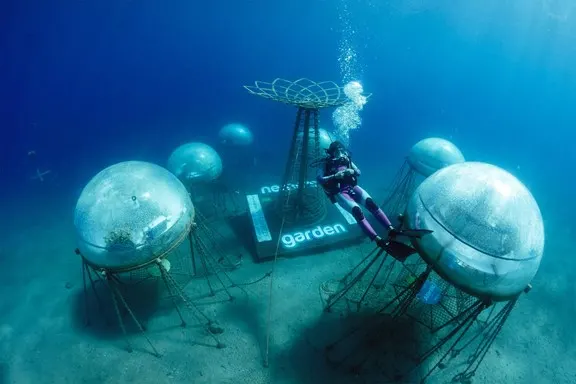The Current State of Underwater Farming Looks Ready for Simulation. The Nemo’s Garden project has been in motion for a decade now—since 2012, when inspiration struck Sergio Gamberini while he was on vacation. The idea to build underwater farming structures was born from thinking about the best possible conditions for growing basil.The ambitious goal of Nemo’s Garden is to “create an alternative system of agriculture, especially dedicated to those areas where environmental conditions, economical or morphologic reasons make plant growth extremely difficult.
”The underwater gardening system contains six biospheres, and each of these spheres is constantly monitored. Air temperature and water temperature inside the spheres are recorded twenty-four hours a day. Light sensors record illumination to make sure that the plants inside the domes get enough exposure to direct sunlight every day. Measuring rates of water evaporation and condensation provides an idea of the relative humidity inside the spheres.Constant monitoring of several characteristics, each called out as a key to optimal performance? Sounds like a case for simulation.

Nemo’s Garden studies underwater farming with the aid of Ssmulation. (Images courtesy of OceanReefGroup 2022.)
Partnering with Siemens has helped Nemo’s Garden to refine the design of the biospheres and automate data input and decision processes. If Nemo’s goal is the creation of a new kind of agriculture, then it makes sense that sustainability alone won’t be enough. New hardware and software will be needed to study the way things are currently done in order to develop new methods. Several studies have shown that the food being produced in the world today might not feed the needs of the people of tomorrow. By bringing farming underwater, more surface area of the Earth can be used to meet this need.
Digital twin technology helps Nemo’s Garden to grow its operation. (Video courtesy of Siemens.)
Underwater Farming for the Two Billion Hungry Mouths Arriving by 2050
When Johnathan Foley developed his five-step plan to feed the world in 2020, a common thread running through it was the idea that we need to do more using less. The world is predicted to house nine billion people by 2050, and the two billion people who are not here yet are going to need to eat.
The first step in Foley’s plan is stopping agriculture’s physical growth. Agriculture is using a lot of space to grow food, with a total area roughly the size of South America being used to grow crops while an area around the size of Africa is being used to raise livestock. Foley said that agriculture is using 38.6 percent of ice-free land, or 19.4 million square miles for crops and livestock.


Bringing agriculture underwater, can be a great way to increase the production of food to meet future needs. (Images courtesy of OceanReefGroup 2022.)
The second step is growing more food on the land already being used for farming. Embracing new technologies and focusing on Africa, Latin America and eastern Europe could bring production in those areas up to the farming yield levels of more well-developed regions.
Using existing resources more efficiently is the third step, taking strategies from organic farming to reduce water and pesticide use. Arguably, the most challenging part of the plan is a shift in the world’s diet. Foley says fifty-five percent of the crops grown today are used for food, while the remainder either goes to feed livestock or produce biofuels.
The last step is reducing waste, with an estimated almost fifty percent of food weight produced in the world currently going to waste. Food service institutions could develop waste-reduction measures, and people could eat leftovers more often.
All five areas of focus in this plan to feed the world have the feel of optimization to them—or at least refining and improving the processes we already have in place. Moonshot-scale ideas such as moving agriculture underwater are not present in the plan. Nemo’s Garden and its commitment to sustainable agriculture can act as a complement to the initiatives already in place, and the project is using technology to optimize itself.
Digitalization, Digital Twins and the Xcelerator
The partnership between Nemo’s Garden and Siemens touches on many different phases of the biosphere project. Luca Gamberini, co-founder of Nemo’s Garden, and Alastair Orchard, Siemens vice president of digital enterprise, answered some questions for us about the ways that the underwater farming experts have used their software tools. Simcenter Amesim was one of the first tools used to understand the relationship between the environment in the biospheres. Water, light, heat, gas and electricity are all working together to grow plants inside the space.

Simcenter STAR-CCM+ calculates lift and drag coefficients for the pods. (Image courtesy of OceanReefGroup 2022.)
Mindsphere gave Nemo’s engineers the ability to take the sensors already in place and build simulations. Having a living model to compare with the Internet of Things (IoT) system simulations provided the engineers with opportunities to fine-tune the system and build stronger digital twins.
The NX models of the system were used to perform stress analysis studies. The digital twin of the spheres could be placed in a digital version of the Bay of Noli to study tidal stresses. Historical data was used to study different sizes of the chains tethering the biospheres to the seabed, finding an optimized thickness. Wave data showing speed, frequency, length and direction helped to build a topological simulation model. That model was then used to study positive effects of the cluster of spheres, hoping that the cover provided could help stop erosion on the shoreline.
Nemo’s CFD engineers used Simcenter STAR-CCM+ and HEEDS software to optimize the size and shape of the spheres against the internal volume of the spheres and the drag coefficient. These models could also be used to study areas of flow around the spheres singularly and in clusters. For example, areas where fast flow occurs can be targeted to place micro-turbines and generate power in the future, while areas of slow flow might be a concern if algae can build up on the surface of the sphere, eventually creeping up to the point where sunlight cannot efficiently reach the plants inside.
The camera streams that monitor the biospheres were used by the corporate technology branch of Siemens in Princeton, New Jersey to create a machine learning algorithm. This algorithm was trained to understand the condition of every plant in every sphere, find the right mix of sphere conditions to maximize the growth rate of each plant and predict the ideal date for harvesting.
The digital manufacturing tool Process Simulate modeled ways that humans could exist and interact inside a sphere. A study was then produced to understand how different end-effectors on robot arms could reach plants at different phases of the growth envelope.
What Does It All Mean?
From a pure engineering inspiration viewpoint, it’s exciting to think that Sergio Gamberini was able to take two strong passions in his life and develop a massive project to change the way we think about agriculture. Nemo’s Garden is a great example for professors teaching morphological matrices as a tool for generating ideas—an engineer loved scuba diving and gardening, so he found a way to do them both at the same time.
If seventy-one percent of the earth is covered in water, figuring out how to farm that space is a worthwhile endeavor. Nemo’s Garden notes that as the project develops even more possibilities open up for the biospheres. Ecotourism, fish farming, seaweed farming and underwater lab facilities are all practical extensions once a robust farming community has been established.
If the only thing keeping us from realizing our Sealab ambitions is a strong underwater food and farming supply, then I’m ready for the future.
Food production is one of the looming problems that society has been largely ignoring in the last decade while engineers and futurists point out the coming crisis. Like access to water, energy production and climate change, food production is one of the big picture engineering challenges that will most likely require several solutions from several areas to meet in order to succeed. If one of the big goals of simulation is to save engineers time in the beginning of a project, then this is the time for us all to be using predictive tools as we work to save the planet.

